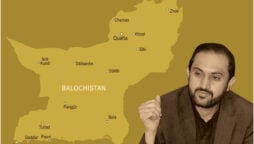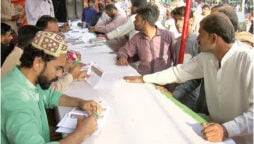
A Daunting Task
KP allocates 26% of development budget for education; yet it may take years to bring every child to school
Khyber Pakhtunkhwa (KP) is the only province of Pakistan to surpass UNESCO benchmark by allocating over 26% of its development budget for education. However, it is still a daunting task for the Pakistan Tehreek-e-Insaf’s (PTI) provincial government to give education to all out-of-school children.
The document of 2021-22 provincial budget reveals that 70% of the amount allocated for education will be utilized for providing education to girls while 30% of the amount is earmarked for boys’ education.
A survey, conducted as part of the Benazir Income Support Programme’s (BISP) National Socio-Economic Registry census, showed that a total of 4.7 million children are out-of-school in the KP. The total population of girls in the province is 5.4 million and around 53% or 2.9 million girls are out-of-schools.
The PTI, which has been ruling the province since 2013, has consistently allocated 20% of its annual budget for education in the last 5 years. The province spent Rs136.2 billion on education in 2017-18, Rs145.9 billion in 2018-19, Rs166.4 billion in 2019-20, and Rs183.7 billion in 2020-21.
In the province’s 2022-23 annual budget, the government has allocated Rs261.27 billion for education – 46% more than the previous year’s allocation.
Under the Constitution, the state is bound to provide free and compulsory education to all children between 5 to 16 years. In the recent past both the federal and provincial governments have taken significant measures in terms of policy and financial reforms to promote access to education for all.
However, the number of out-of-school children in the KP’s settled districts has gone up to 3.7 million in 2021 despite huge spending on education.
The BISP survey report highlights a serious crisis of education and especially girls’ education in the newly merged districts – which were part of the Federally Administered Tribal Areas (Fata) till 2018.
According to the report, around 1.8 million children were out-of-school in these seven districts which remained a hotbed of militancy for over a decade.
Different reports compiled by government organizations as well as the NGOs, media outlets and independent researchers reveal the unsatisfactory state of girls’ education in the province.
They highlight problems like unavailability of primary, middle and secondary schools in different areas, lack of facilities, poverty, overcrowded classrooms and labs at government schools, lack of proper counseling of girls at secondary level and poor sanitation and menstrual hygiene management
Early and child marriages, family education patterns, lack of role models, bad security situation, social disharmony and rural urban differences are also reported as some factors barring girls from enrolling in schools or continuing their education.
Education experts appreciate the increase in budgetary allocation for education but believe that equity based budgeting with increased resources is critical to enhancing girls’ education in the province.
According to some estimates, there is a need for 15,000 more schools in the province to accommodate 4.7 million out-of-school children along with an efficient resource allocation to provide relevant education facilities.
The KP government’s assessment plan shows that only 300 schools can be built in a year. If the province continues to build new schools at this rate, it will take at least 50 years to provide educational facilities to the 4.7 million out-of-school children.
To address the issue, the government may go for second and third shifts in every school or embark on public-private partnerships but challenges surround these measures as well.
Experts are of the opinion that in view of the increase in the number of out-of-school children from 1.8 million to 4.7 million, the government must ensure that budgets are gender-responsive and equity oriented, prioritizing gender equality and girls’ education.
They believe that the government should allocate a budget with efficient development schemes to promote girls’ education in the KP, especially in newly merged districts.
Qamar Naseem, chief executive of the Blue Veins, said the government must focus on leveraging domestic financing towards gender equality in education and basing decisions on strong cost-effectiveness evidence. “The KP is so far doing excellent but still much has to be done.”
He said recognition of the different effects of education spending on girls and boys is the foundation of gender-responsive public expenditure management (GRPEM). “Spending must be oriented to redress imbalances. Gender sensitivity must be practiced in how funds are allocated and accounted for.”
Qamar said the post-pandemic public expenditure discussions must be informed by an understanding of the impact the interruption of school will have on more vulnerable girls, with impacts ranging from lost learning and an increase in dropout rates, which also need an immediate attention”
Pakistan Youth Change Advocate (PYCA) Program Director Areeba Shahid said there is a need for quality education financing for schools.
“Global funders and local investors need to actively play a role in making resources available to build middle and higher secondary schools in the public as well as private sector,” she said.
To another query, she said: “Girls’ education should be incentivized by subsidizing school fees or by providing stipends at every level to attract girls to education, especially in underdeveloped areas of the KP, like the newly merged districts, where poverty is one of the causes for dropout of girls from schools.”
“Awareness about the importance of educating women and girls and the impact it has on families’ needs to be raised also if we really want to minimize the girls dropout ratio,” she added.
She said allocation of 70% education budget for girls education is no doubt a very important measure.
“This would ensure equitable distribution of resources and help bring more girls to school more quickly. That said, increasing the overall volume of the education development budget in absolute terms is extremely important to strengthen and sustain the momentum.”
“At the same time, the government must also invest in behaviour change campaigning in the merged areas to help communities understand the value that secondary and higher education brings in the lives of girls and their communities as a whole.”
Catch all the National Nerve News, Breaking News Event and Latest News Updates on The BOL News
Download The BOL News App to get the Daily News Update & Live News.












 Read the complete story text.
Read the complete story text. Listen to audio of the story.
Listen to audio of the story.